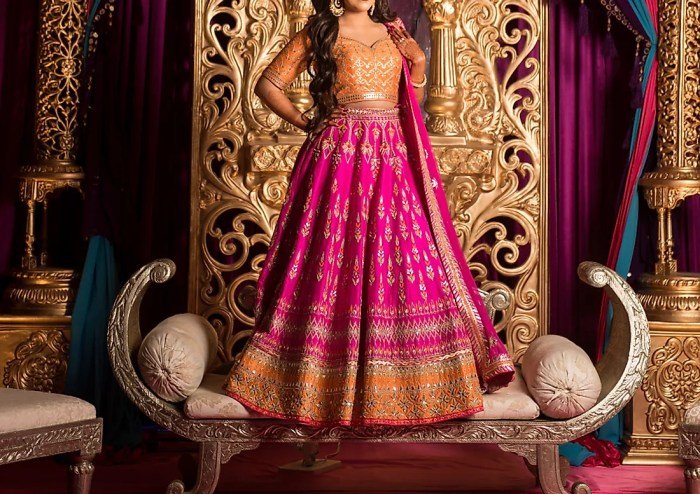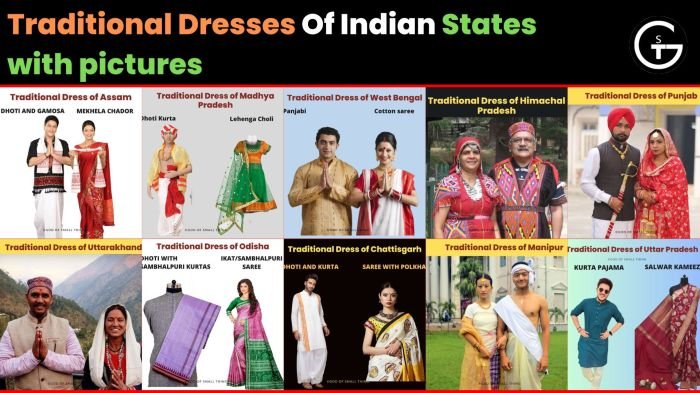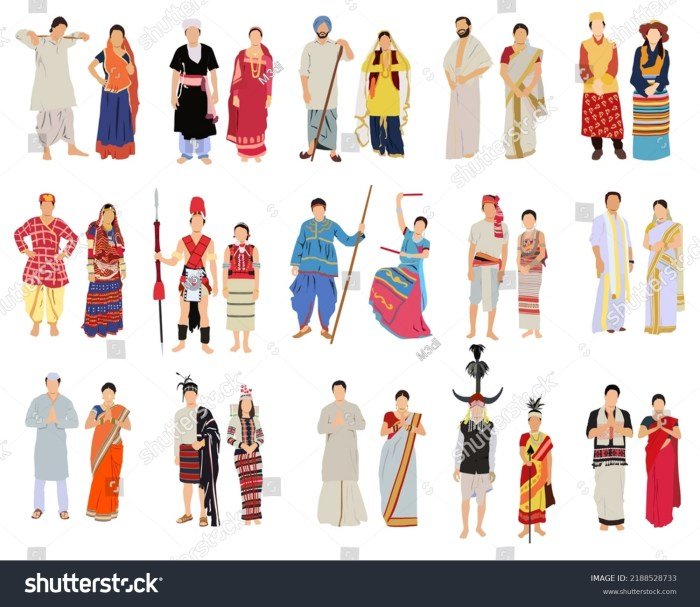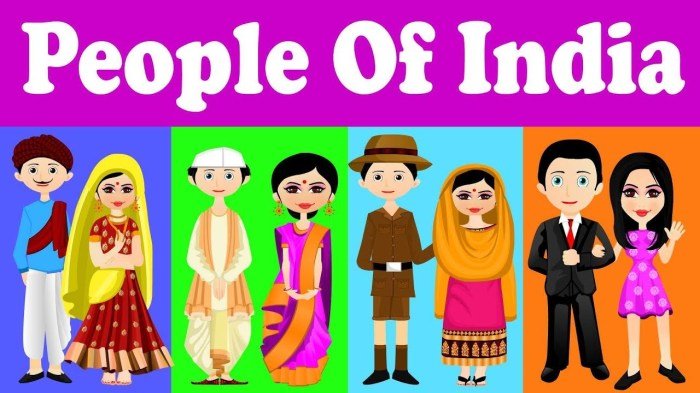Different traditional dresses of India are a symphony of vibrant colors, intricate designs, and rich cultural heritage. From the elegant drape of the sari to the vibrant hues of the lehenga choli, each attire tells a unique story of regional traditions and artistic expression.
Across the vast landscape of India, traditional dresses showcase a kaleidoscope of styles, influenced by diverse geographies, customs, and beliefs. This exploration delves into the history, significance, and modern interpretations of these timeless garments.
Traditional Dresses of India

India, a land of diverse cultures and traditions, boasts a vibrant array of traditional attire that reflects its rich history and regional influences. From the elegant saris to the vibrant lehengas, each traditional dress holds a special significance and tells a unique story.
The origins of traditional Indian dresses can be traced back to ancient times, with influences from various civilizations and dynasties. The climate, geography, and cultural practices of different regions have shaped the evolution of these dresses, resulting in a stunning variety.
Regional Diversity
The diverse geography of India has given rise to a wide range of traditional dresses, each reflecting the unique cultural heritage of different regions.
- North India:Salwar kameez, kurta, dhoti, sherwani
- South India:Sari, dhoti, lungi, half-saree
- West India:Ghagra choli, dhoti, lungi
- East India:Sari, salwar kameez, mekhela chador
- Northeast India:Mekhela chador, phanek, riha
Types of Traditional Dresses for Women

Traditional Indian dresses are renowned for their vibrant colors, intricate designs, and rich cultural significance. Among the diverse range of attire, the sari, salwar kameez, and lehenga choli stand out as iconic representations of Indian women’s fashion.
Sari, Different traditional dresses of india
The sari, a timeless drape, is the most recognizable Indian garment. Originating in the Indus Valley Civilization, the sari is an unstitched fabric that measures around 5-6 yards in length. Typically made from silk, cotton, or georgette, the sari’s versatility lies in its draping style, which varies across different regions of India.
The most common style involves wrapping the fabric around the waist, with one end draped over the shoulder, creating an elegant and graceful silhouette.
Salwar Kameez
The salwar kameez, a comfortable and versatile ensemble, consists of three pieces: the kameez, salwar, and dupatta. The kameez, a long tunic, is typically paired with a salwar, loose-fitting trousers that taper at the ankles. A dupatta, a long scarf, completes the outfit, adding a touch of color and style.
India boasts a rich tapestry of traditional dresses, each region adorned with its unique attire. From the vibrant lehengas of Rajasthan to the elegant saris of Bengal, the diversity is captivating. Yet, amidst this cultural kaleidoscope, one cannot overlook the timeless appeal of frank & eileen dresses.
With their understated elegance and comfortable fabrics, these dresses seamlessly blend modern sensibilities with the timeless charm of Indian heritage.
Salwar kameez is a popular choice for everyday wear, as it allows for freedom of movement while maintaining a modest and graceful appearance.
India is a land of diverse cultures, and its traditional dresses reflect this diversity. From the vibrant colors of theサリー to the intricate embroidery of the लहंगा, each dress tells a unique story. If you’re a bridesmaid wondering when to buy your dress, the best time is usually around 6-8 months before the wedding.
This will give you plenty of time to find the perfect dress that fits your style and the wedding theme. Once you’ve chosen your dress, you can start planning the rest of your bridesmaid attire, such as your shoes and accessories.
As you plan your bridesmaid look, don’t forget to explore the different traditional dresses of India for inspiration.
Lehenga Choli
The lehenga choli, an elaborate and regal attire, is reserved for special occasions such as weddings and festivals. The lehenga, a long, flared skirt, is often adorned with intricate embroidery, beadwork, or mirror work. The choli, a fitted blouse, complements the lehenga, showcasing the wearer’s figure.
A dupatta, draped over the head or shoulders, adds a touch of elegance and completes the ensemble. Lehenga cholis are known for their vibrant colors, opulent designs, and the sheer beauty they exude.
India boasts a rich tapestry of traditional dresses, from the vibrant lehengas of the north to the elegant saris of the south. While each region has its own distinct style, they all share a common thread of vibrant colors and intricate embellishments.
If you’re looking for inspiration for your own traditional attire, you may also want to explore quinceanera dresses website for a touch of Latin American flair. However, remember that the beauty of traditional Indian dresses lies in their unique fusion of colors and textures, creating a symphony of cultural expression.
Regional Variations in Traditional Dresses

Traditional Indian attire varies greatly across different regions, each with its own unique style and cultural significance. Let’s explore the diverse regional variations in traditional dresses worn by women in India.
The vast country of India is home to a diverse array of cultures and traditions, each with its own unique style of traditional dress. These regional variations in traditional dresses reflect the cultural heritage, geographical location, and climate of each region.
North India
North India, known for its vibrant colors and rich embroidery, has a variety of traditional dresses. In Punjab, women wear the salwar kameez, a loose-fitting tunic paired with wide-legged trousers. Rajasthan is famous for its ghagra choli, an ankle-length skirt worn with a fitted blouse and a dupatta (a long scarf).
Uttar Pradesh is known for its chikanकारी work, an intricate embroidery technique used on kurtas (long tunics) and saris.
South India
South India, with its tropical climate and coastal influence, has a more relaxed and flowy style of traditional dress. In Tamil Nadu, women wear the sari, a long piece of fabric draped elegantly around the body. Kerala is known for its mundum neriyathum, a two-piece garment consisting of a white cotton skirt and a colorful blouse.
Karnataka is famous for its ilkal sari, known for its intricate weaving and vibrant colors.
East India
East India, with its rich cultural heritage and artistic traditions, has a unique style of traditional dress. In West Bengal, women wear the sari, often adorned with intricate embroidery or woven motifs. Odisha is known for its handloom sarees, such as the Sambalpuri and Bomkai sarees, which are characterized by their vibrant colors and traditional designs.
Assam is famous for its mekhela chador, a two-piece garment consisting of a cylindrical skirt and a rectangular shawl.
Modern Interpretations of Traditional Dresses
Traditional Indian dresses have undergone significant transformations to align with evolving fashion trends. Contemporary designs incorporate new fabrics, embellishments, and silhouettes, blending tradition with modernity.
Fusion Wear
Fusion wear seamlessly combines elements of traditional Indian dresses with Western styles. For example, a traditional lehenga may be paired with a contemporary blouse or a kurta may be styled with jeans. This fusion creates versatile and stylish outfits suitable for various occasions.
Everyday Fashion
Traditional dress elements are also being incorporated into everyday fashion. Embroidered blouses, flared skirts, and intricate jewelry are now common sights in casual wear. This integration brings a touch of ethnic flair to everyday attire.
New Fabrics and Embellishments
Modern designers are experimenting with new fabrics such as organza, silk blends, and georgette to create lightweight and flowy dresses. Embellishments like sequins, beads, and embroidery are used in innovative ways to add a touch of glamour and sophistication.
India is a land of diverse cultures, and its traditional dresses reflect this diversity. From the elegant sarees of the south to the vibrant kurtas of the north, there is a wide range of styles to choose from. If you are looking for a traditional Indian dress in a plus size, there are many options available online.
You can buy plus size dresses online india from a variety of retailers, including Shein. Shein offers a wide selection of plus size dresses in different styles, colors, and fabrics. Whether you are looking for a traditional sari, a modern kurta, or something in between, you are sure to find the perfect dress at Shein.
Silhouette Variations
Traditional silhouettes are being reimagined with modern twists. Dresses may feature asymmetrical cuts, layered fabrics, and unique necklines. These variations create contemporary and eye-catching designs that cater to the evolving tastes of fashion-forward individuals.
Styling Traditional Dresses

Styling traditional Indian dresses is an art form that can elevate your look and make you stand out. Here are some tips on how to accessorize and style traditional Indian dresses for different occasions:
Accessories
Jewelry is an essential part of styling traditional Indian dresses. Choose pieces that complement the outfit and occasion. For example, a heavy necklace and earrings would be appropriate for a wedding, while a simple pendant and studs would be more suitable for a casual event.
Footwear is another important consideration. Heels or wedges can elongate your silhouette and add a touch of glamour, while flats or sandals are more comfortable for everyday wear.
Makeup
Makeup can help to complete your traditional Indian look. A bold lip color and smoky eyes can create a dramatic effect, while a more natural look is appropriate for daytime events.
Fusion Outfits
Traditional Indian dresses can also be paired with modern pieces to create fusion outfits. For example, you could wear a traditional kurta with a pair of jeans or a lehenga with a crop top.
Cultural Significance and Impact
Traditional dresses hold immense cultural significance in Indian society, deeply interwoven with the nation’s rich heritage and diverse cultural tapestry.
These attire are not merely garments; they embody cultural identity, traditions, and social customs. Each region of India boasts its unique styles, colors, and motifs, reflecting the country’s vibrant cultural diversity.
Role in Festivals and Cultural Events
Traditional dresses play a pivotal role in festivals and cultural events, adding to the grandeur and festivity. During festivals like Diwali, Holi, and Dussehra, people adorn themselves in their finest traditional attire, creating a vibrant and colorful spectacle.
Weddings are another significant occasion where traditional dresses take center stage. Brides and grooms often opt for elaborate and ornate traditional attire, reflecting their cultural heritage and the auspiciousness of the event.
Impact on Indian Art, Music, and Literature
Traditional dresses have left an enduring mark on Indian art, music, and literature. In paintings and sculptures, depictions of traditional attire provide a glimpse into the cultural history and customs of different regions.
In music, traditional dresses are often mentioned in folk songs and ballads, describing their beauty and significance. Literature, too, has celebrated the charm and allure of traditional attire, weaving them into stories and poems that capture the essence of Indian culture.
Closing Summary

The different traditional dresses of India are not mere garments; they are living embodiments of cultural identity, artistic flair, and historical narratives. Their evolution and continued relevance in contemporary fashion speak to the enduring power of tradition in a rapidly changing world.
Question & Answer Hub: Different Traditional Dresses Of India
What is the most popular traditional dress in India?
The sari is considered the most iconic and widely worn traditional dress in India, known for its versatility and elegance.
What is the difference between a salwar kameez and a lehenga choli?
A salwar kameez consists of loose trousers (salwar), a long tunic (kameez), and a scarf (dupatta), while a lehenga choli comprises a long skirt (lehenga), a blouse (choli), and a dupatta.
How do traditional Indian dresses reflect regional diversity?
Traditional dresses vary significantly across different regions of India, influenced by local climates, cultural practices, and artistic traditions.